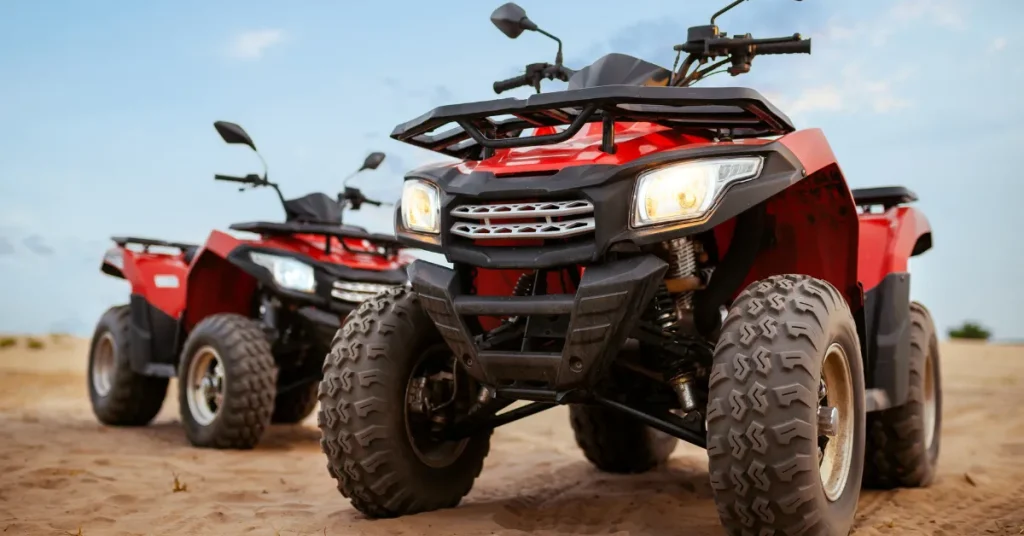An ATV typically ranges in width from 45 to 50 inches. This size allows for stability and maneuverability off-road.
ATVs, or All-Terrain Vehicles, are popular among outdoor enthusiasts for their versatility in various environments, from forests to sand dunes.
Designed to handle a wide range of terrains, these vehicles come equipped with low-pressure tires and a seat that the rider straddles, similar to a motorcycle, but with the stability offered by four wheels.
The width of an ATV is essential for determining its suitability for specific trails and storage space requirements. Knowing the dimensions is critical for riders to ensure compliance with local regulations and to maintain safe riding practices.
Whether used for recreation, work, or sport, the ATV’s width directly impacts its performance and the rider’s experience.

Exploring Atv Size Variations
ATVs, or All-Terrain Vehicles, come in many sizes. Each size fits a different need for riders. Riders pick an ATV size for trail width, storage, and transport ease. There’s a lot to think about when choosing the right ATV width. Let’s dive into exploring the size variations of ATVs.
Why Atv Width Matters
ATV width affects how you ride and where you can go. Wider ATVs offer more stability and comfort. Yet, they may not fit on narrow trails. Narrow ATVs can move through tight spaces easier. They are also simpler to transport and store.
Typical Atv Width Categories
Different ATVs serve different purposes. Here is a quick look at the typical width categories:
- Utility ATVs: These are for work and off-roading. They are about 45 to 50 inches wide.
- Sport ATVs: Made for speed and agility, they measure 40 to 48 inches wide.
- Youth ATVs: These are smaller for young riders. They typically sit around 30 to 40 inches wide.
- Side-by-Side ATVs: Also known as UTVs, these can be up to 65 inches wide or more.
| Type | Width Range (inches) |
| Utility ATVs | 45-50 |
| Sport ATVs | 40-48 |
| Youth ATVs | 30-40 |
| Side-by-Side ATVs (UTVs) | 65+ |
Factors Influencing Atv Width
Understanding the width of an ATV is crucial for various reasons, including trail compliance, storage, and transportation.
Several factors influence how wide these vehicles are, from their intended usage to manufacturer design choices and legal requirements. Exploring these elements provides insight into the diversity of ATV sizes available on the market.
Design Purpose And Terrain
The design of an ATV largely depends on its intended purpose and the type of terrain it will navigate. For example:
- Utility ATVs: Often wider for stability during heavy work or on uneven terrain.
- Sport ATVs: Typically narrower for agility and quick maneuvers in races or on trails.
- Youth ATVs: Smaller in size for safety and manageability by younger riders.
Different terrains also demand specific width dimensions:
- Wide trails or open spaces: Accommodate larger ATVs for comfort and functionality.
- Narrow trails: Require slimmer ATVs to fit through restrictions and natural obstacles.
Manufacturer Specifications
Manufacturers design ATVs with a specific width that aligns with the vehicle’s performance and use. These specifications often reflect:
Brand philosophy:
Some brands may focus on compact models while others build wider ATVs for extra stability.
Model variations:
Each model may offer different widths to cater to various consumer needs.
Buyers must assess these specifications to choose an ATV that suits their requirements best.
Regulation And Compliance
Legal standards play a significant role in ATV width. Regulations vary by region, impacting:
| Trail Limits | ATV Size Categories |
| Specify the maximum width allowed on certain trails. | Determine which ATVs are permitted based on their dimensions. |
Compliance with these rules is essential to avoid fines and ensure safe, lawful use of ATVs.
The Compact Class: Small Atvs
The Compact Class: Small ATVs offer agility and accessibility for riders looking for a versatile four-wheeler. These compact workhorses can navigate narrow paths and perform tasks with ease.
Dimensions And Use Cases
Small ATVs typically measure between 50-60 inches in width and have a wheelbase that seldom exceeds 70 inches. This size enables riders to pass through tight spots and manuever with simplicity.
- Trail Riding: Perfect for single-track trails.
- Farm Use: Navigate through gates and barn doors easily.
- Young Riders: Safe and manageable for beginners.
Popular Compact Atv Models
Top choices in this category satisfy a range of needs.
| Model | Dimensions (WxLxH) | Engine Size | Special Features |
| Honda Recon 250 | 40.7″x75″x42.1″ | 229cc | Efficient fuel economy |
| Kawasaki Brute Force 300 | 42.5″x75.3″x46.1″ | 271cc | Automatic transmission |
| Polaris Sportsman 450 H.O. | 48″x83″x47″ | 500cc | On-Demand AWD |
Riders choose these models for their reliability and ease of use.
Standard Workhorses: Midsize Atvs

Thrill seekers and hard workers alike turn to ATVs for their versatile capabilities. Standing tall in this diverse lineup are midsize ATVs, known for their blend of power and agility.
These ATVs serve as the go-to choice for both everyday work and recreational purposes. Let’s delve into the unique qualities that make midsize ATVs the standard workhorses of the off-road world.
Utility Versus Recreation
Midsize ATVs split the difference between heavy-duty labor and fun-loving adventure. Their design caters to a range of activities:
- Utility ATVs: Equipped for towing and hauling.
- Recreation ATVs: Optimized for trail riding and sports.
Depending on the model, features like cargo racks and tow hitches on utility ATVs assist in farm work or hunting, while recreation ATVs flaunt superior suspension systems for rider comfort during rough rides.
Finding The Middle Ground
Midsized ATVs strike a perfect balance for many enthusiasts. Weighing a compromise between size and power, these ATVs usually measure:
| Width | Length | Height |
| 42-48 inches | 70-85 inches | 45-49 inches |
This midrange size allows for easier navigation through tight trails than larger models, yet provides enough muscle for towing and load-bearing tasks. It’s a choice pick for those requiring an ATV that can handle both work and play with ease.
Behemoths Of The Trail: Large Atvs
Big, bold, and built for rough terrain, large ATVs are the kings of off-road adventures. These powerful machines turn heads as they rumble down trails. With their hefty size, they promise thrilling rides and unbeatable capability. They’re perfect for those who think bigger is better.
The Power Of Size
Size matters on the trails. The physical dimensions of large ATVs reflect their strength. Riders need to know these measurements. It ensures the ATV fits on trails and in storage spaces.
- Width: Ranges from 48 to 60 inches for most large models
- Length: Can stretch up to 94 inches
- Height: Towers up to 49 inches
- Weight: Between 700 to 1,000 pounds
Big Atvs In Action
Large ATVs handle tough jobs and challenging terrains with ease. They’re not just for show. Their width adds stability. It makes climbing steep inclines or navigating rocky paths less risky.
| Benefit | Description |
| Improved Stability | Broader stance reduces risk of tipping |
| More Power | Engines suited for hauling and towing |
| Greater Comfort | Spacious seating for long rides |
| Versatility | Useful for recreation and work tasks |
These ATVs suit various purposes. They are excellent for work on farms or for leisure in the outdoors. Riders relish the power that comes with the larger size.
Measuring Your Path: Trail And Transport Considerations
Understanding the width of an ATV is crucial for adventure and practicality. Whether threading through narrow forest trails or loading your ATV for a getaway, size matters. Trail navigation and transportation hinge on the ATV’s dimensions. Let’s explore what to consider.
Trail Width Restrictions
Before venturing out, knowing trail limits is imperative for a smooth ride. Many trails have width restrictions to maintain the trail’s integrity and safety for riders. These are typically:
- 50 inches for narrow trails
- 60 inches or more for wider trails
Confirm the regulations of your chosen trail. Measure your ATV’s width to ensure it complements the trail’s rules. This prevents any on-site surprises.
Transporting Different Atv Sizes
When it comes to hauling your ATV, size dictates your strategy. Different ATVs require various transport methods:
| ATV Type | Average Width | Transport Option |
| Sport Quads | 45-50 inches | Pick-up Truck |
| Utility ATVs | 45-50 inches | Trailer |
| Side-by-Sides | 60-65 inches | Larger Trailer |
Measure your vehicle’s loading area to ensure it fits your ATV. Opt for a trailer if needed. Safety and convenience during transport are vital.
Making The Right ATV Choice: What You Need To Know

Choosing the right size ATV is crucial for both enjoyment and safety. The width of an ATV impacts its stability, maneuverability, and where you can ride it.
Before you pick one, understand what size fits your needs best. This guide simplifies crucial factors to consider, ensuring you make an informed decision.
Balancing Size And Needs
ATVs come in various sizes, typically ranging between 35 to 50 inches in width. To determine what size works best, consider these points:
- Trail Restrictions: Some trails have width restrictions, so choose an ATV that can legally and safely navigate your favorite trails.
- Rider experience: Beginners might prefer a narrower, more controllable ATV, while experienced riders might opt for wider models for stability.
- Utility needs: If you’re using the ATV for chores or hauling, a wider ATV might provide better handling under load.
- Transportation: Ensure your ATV fits on trailers or in storage areas, keeping its width in mind.
The Future Of Atv Design
Innovations in ATV design continue to evolve. New models may emphasize adjustable width or modular structures for various uses. Upcoming features could include:
- Adjustable-width technology for adapting to different trails.
- Lighter materials offering stability without increasing size.
- Hybrid designs blending utility with sport performance.
Staying informed on these trends can influence your choice, offering a future-proof investment.
FAQs About How Wide Is An Atv
How Wide Is A 450 Quad?
A typical 450 class quad bike is approximately 45-48 inches wide. This width ensures stability and maneuverability for the rider.
How Wide Is A Side By Side Atv?
A side-by-side ATV typically ranges from 48 to 65 inches in width, designed for stability and performance on varied terrains.
What Is The Size Of A Four Wheeler?
A four-wheeler, also known as a quad bike or ATV, typically ranges in length from 6 to 7 feet, has a width of about 4 feet, and stands approximately 4 feet tall.
How Big Is A 250 Atv?
A 250cc ATV typically measures around 70 inches in length, 40 inches in width, and 43 inches in height. Its average weight is roughly 400 pounds.
Conclusion
Navigating the dimensions of ATVs needn’t be complex. We’ve outlined a wide range, from sleek 50-inch models to robust 60-inchers.
Selecting the right width supports optimal performance and safety. As enthusiasts or professionals, embracing your specific needs ensures the best ATV experience.
Gear up for the ride ahead, armed with this essential knowledge.
Resources:
1. https://www.oregon.gov/oprd/ATV/Pages/ATV-Classifications.aspx
